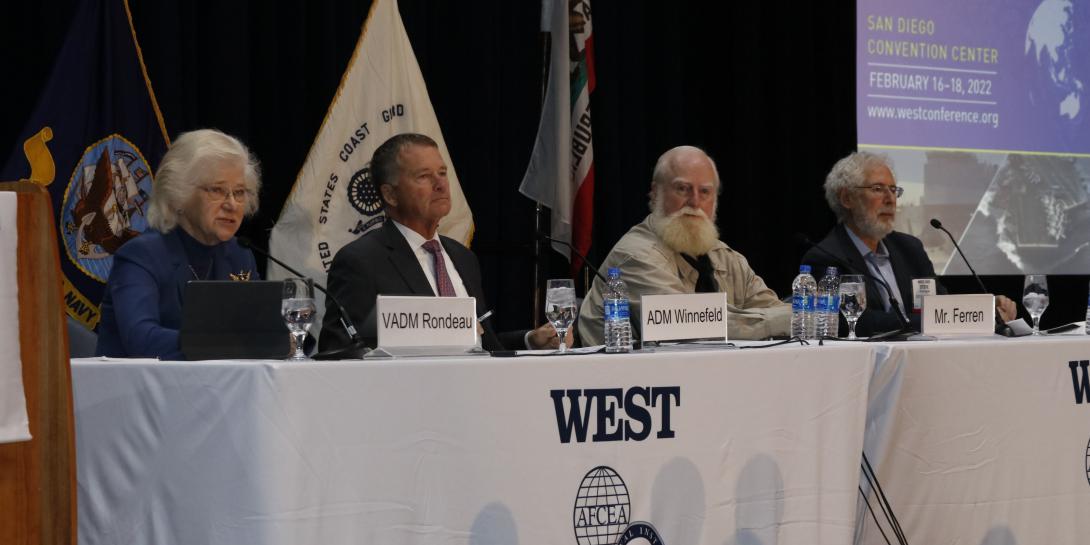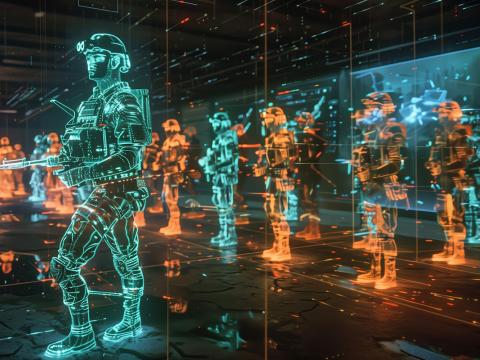Panelists Challenge U.S. Navy's Strategic Thinking
A WEST conference and exhibition panel discussion designed deliberately to be provocative questioned whether the U.S. Navy’s strategy permits the kind of innovation necessary to vie with peer competitors such as China.
Vice Adm. Ann Rondeau, USN (Ret.), president, Naval Postgraduate School, moderated the discussion. The panel also included Adm. James Winnefeld Jr., USN (Ret.), former vice chairman, Joint Chiefs of Staff; Bran Ferren, co-founder and chief creative officer, Applied Minds LLC; and Steve Blank, adjunct professor, Stanford University and senior fellow for innovation, Columbia University.
Adm. Winnefeld outlined three innovation horizons. The first would include incremental technical and tactical changes that fit into the current strategic concept. Examples might include building radar systems with greater range or missiles that are a little more accurate.
The second innovation would include a step up in innovation, such as stealth technology, precision-guided weapons or even machine learning coupled with directed energy weapons. But it would still fit within the current strategy.
“Now, we do those first two horizons really, really, really well as a military and as a country. Those are actually very important pacing efforts that help us extend our strategy as our competitor grows closer to overthrowing it. But we can only take extension so far before the strategy still breaks,” Adm. Winnefeld asserted.
The third horizon forces a rethinking of the entire strategic concept, which “is culturally very, very difficult,” he said.
Adm. James Winnefeld Jr., USN (Ret.) former vice chairman, Joint Chiefs of Staff: Any exposed forces that we actually get to the fight will be facing weapons we’ve never before faced, or be pushed outside ranges that are relevant to the high pace of combat operations. #WEST2022
— George Seffers (pronounced See furs) (@gseffers) February 18, 2022
One way to rethink China is to re-imagine its center of gravity. That center of gravity is what the adversary fears the most. “That center of gravity, as with any totalitarian government, is their leadership and what they wake up in the morning and actually fear, which is namely control of their people. We see this fear every single day in China’s behavior. Just look at the Olympics,” the admiral said. “And we’re actually seeing it today with Russia who’s paranoid about having a free and democratic Ukraine sitting on their border.”
However, targeting that center of gravity under a new strategy does not necessarily mean jumping into high-end fights with a committed peer adversary in his own backyard. “Rather, it speaks to a whole-of-government solution that holds at risk the economic and social underpinning of the mandate, applying all our national instruments of power in ways that present dilemmas along a rich escalation ladder in which the military takes part.”
And that “implies a few different capabilities for our Navy that we either don’t have enough of, or that we have allowed to atrophy, or that we don’t even have at all,” Adm. Winnefeld said.
Furthermore, he suggested working on a long-term, future strategy is necessary “If we’re going to serve our nation well” because the country is at a tipping point and “we don’t have much time,” he warned.
For his part, Ferren criticized the federal acquisition regulation (FAR) and the outdated requirements process for developing new technologies or acquiring new systems. “I firmly believe that if we wanted to vanquish any enemy, we just have to get them to adopt our process, and we would be safe,” Ferren joked. “We’ve come to the stage where we’re paralyzing ourselves with regards to innovation for government systems, the military, etc."
The process is too slow and requires officials to have the answer to generate the requirements before they even know the question, he said, adding that common sense has been suspended. “We don’t do strategic or long-term thinking anymore. If anything, we may do long-term tactical thinking and call it strategic, but it’s really just a spreadsheet exercise. … That’s not a survivable model.”
Bran Ferren, co-founder and chief creative officer, @appliedminds: If anything, we may do long-term tactical thinking and call it strategic, but it’s really just a spreadsheet exercise.#WEST2022
— George Seffers (pronounced See furs) (@gseffers) February 18, 2022
Blank suggested that a more far-reaching strategy might not focus on Carrier Strike Groups. He pointed out that Carrier Strike Groups and submarines have been the preeminent formation for U.S. naval warfare for 80 years, and China has been watching those same formations for decades.
Blank questioned what would happen if the Carrier Strike Groups can no longer win a fight and hinted the United States may be underestimating China’s capabilities, intents, imagination and operating concepts. “What if they could disable a destroyer or strike group via cyber, conventional weapons, hypersonics—the whole list of capabilities they’ve been working very hard?
The Navy’s plans call for a distributed fleet architecture and a mix of manned ships and unmanned ships, he noted. At the same time, however, the Navy’s ships are large and complex and take too long to manufacture and are too expensive for the service to afford as many as needed. “What’s the plan B?” Blank asked.
One proposal is what he called “the small, the agile and the many,” which calls for hundreds or thousands of unmanned vehicles, in the air, as well as on and below the ocean surface. All of them could be communicating and collaborating as autonomous formations. “This requires a different worldview, one that’s no longer tied to the 20th century industrial systems we still kind of operate on. It requires us to understand software is the new platform,” Blank said. “We should observe that the Navy has world-class engineering and acquisition processes to deal with hardware, but it’s quite embarrassing when applied to software and digital systems.”
Ferren picked up on that theme. “We have these expensive things called carriers, which are very effective, very impressive when they show up and do a whole bunch of things—until you have an enemy who’s really serious and wants to take them out because then they disappear very quickly,” he said.
Ferren described “fractionated concepts” of swarms or even super swarms of thousands of autonomous systems. Some might be big enough to carry missiles, others measured in mere inches. Some might “swim up to an electro-optical aperture and squirt tar on it or go into gun barrels and just melt,” he said, calling it a scalable concept that actually takes advantage of industry innovation. “Now the problem is China’s better at it than we are. If we were going to go build 10,000 entities or 20,000 of them, we’d probably ask China to do it for us, which might not be the best strategy for this.”
He also floated the idea of a ship designed to manufacture unmanned systems on demand. The "force generator" ship might be as big as a carrier, but it would provide mines or unmanned aerial vehicles and undersea unmanned vehicles to act as communications relays or intelligence, surveillance and reconnaissance capabilities "on demand when you need them to deal with a problem."
Adm. Winnefeld touted the need for smart offensive mines. “The state of offensive mine warfare in the Navy—I’m sorry folks—is just appalling,” he said, noting that the Navy is focused on countering mines placed by others rather than placing its own. “It’s a powerful, powerful tool. My goodness, compare what we have today to what the art of the possible would be with machine learning and communications and new materials and power technologies and all kinds of great stuff you could throw in those devices,” he said. “You could scare the living daylights out of China and use it to either shut down their economy or help Taiwan defend itself."





Comments